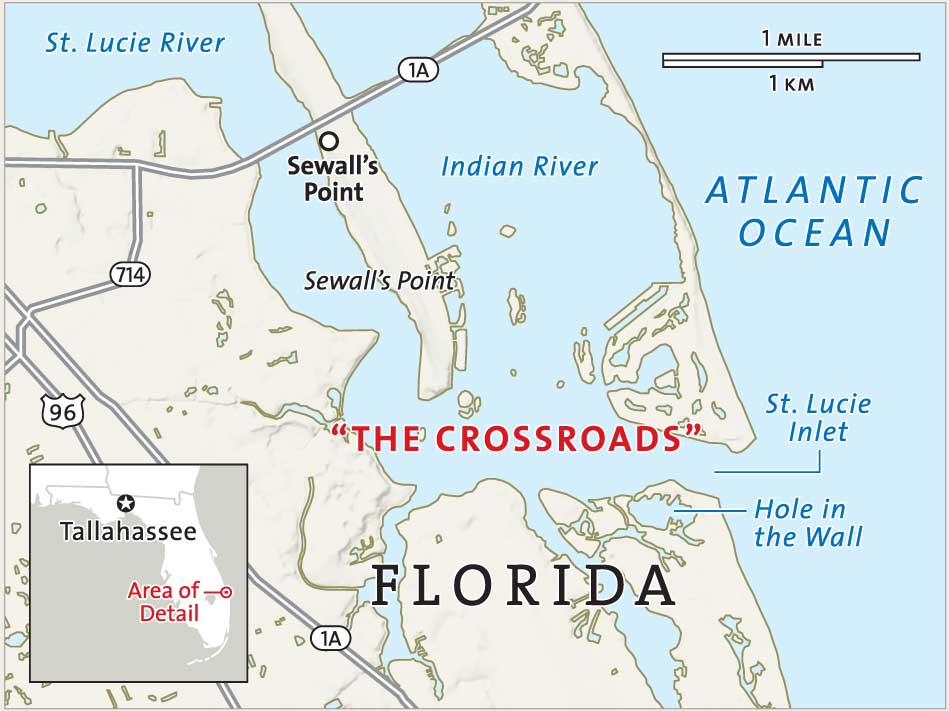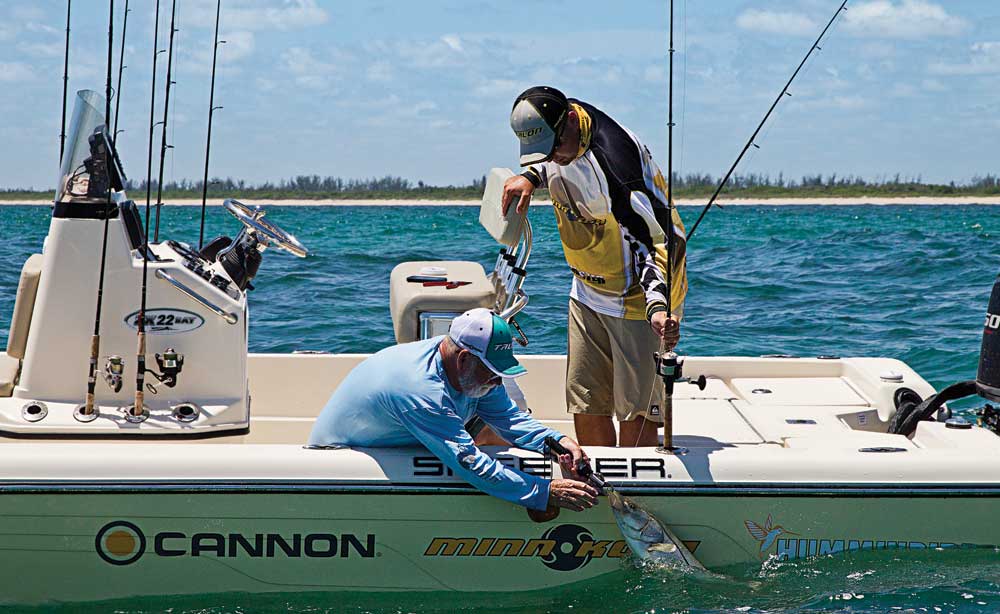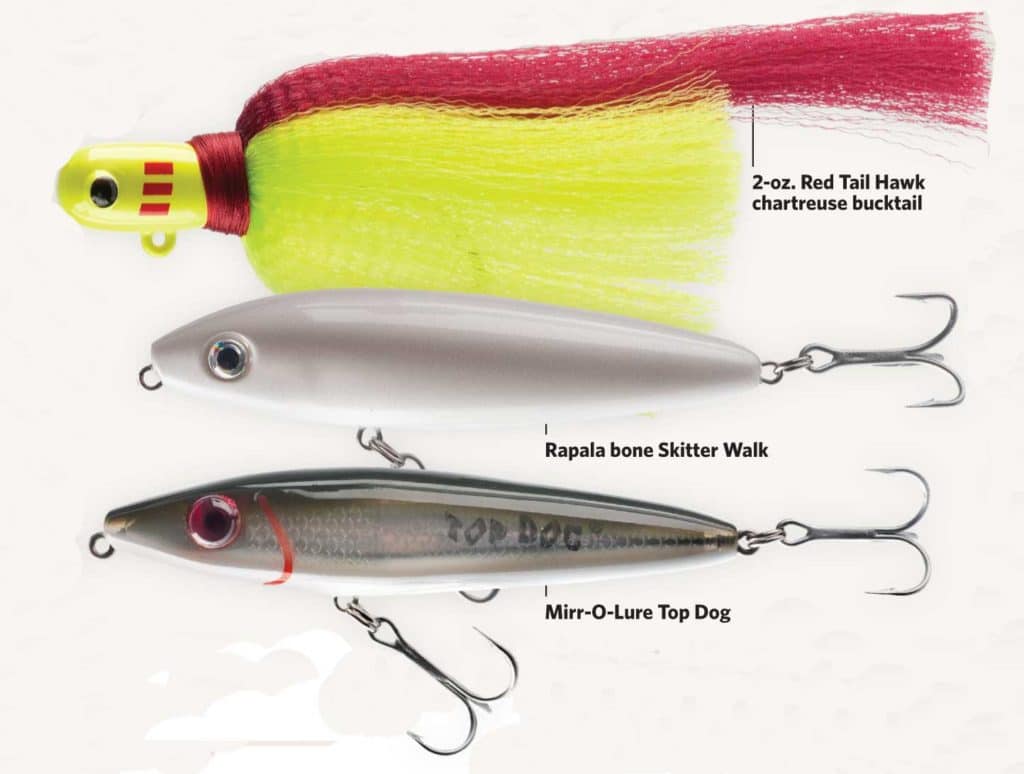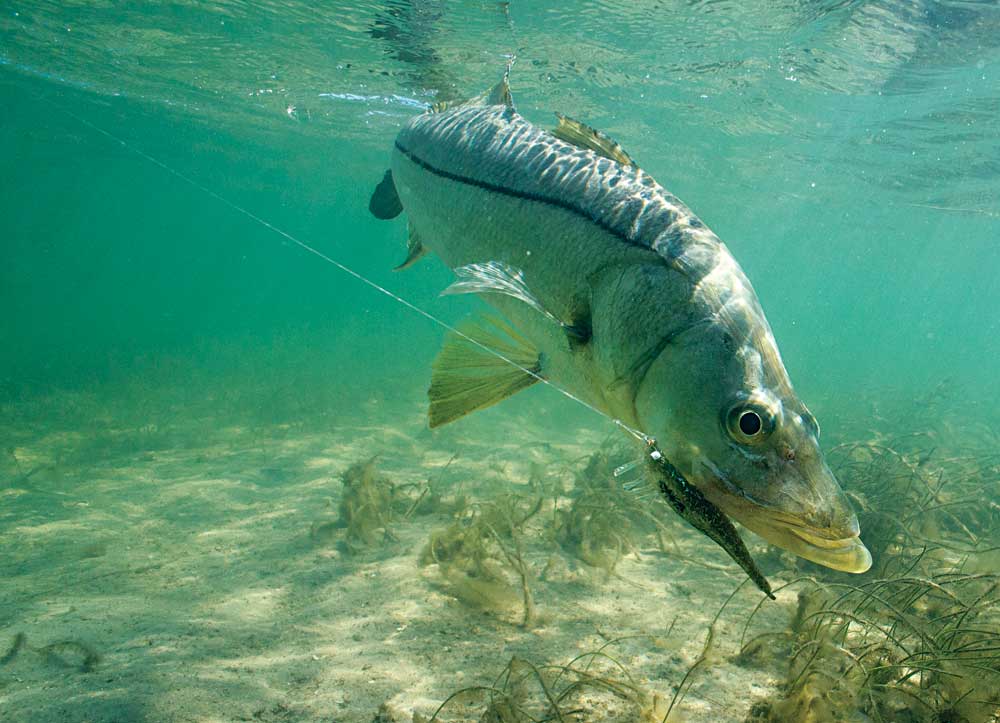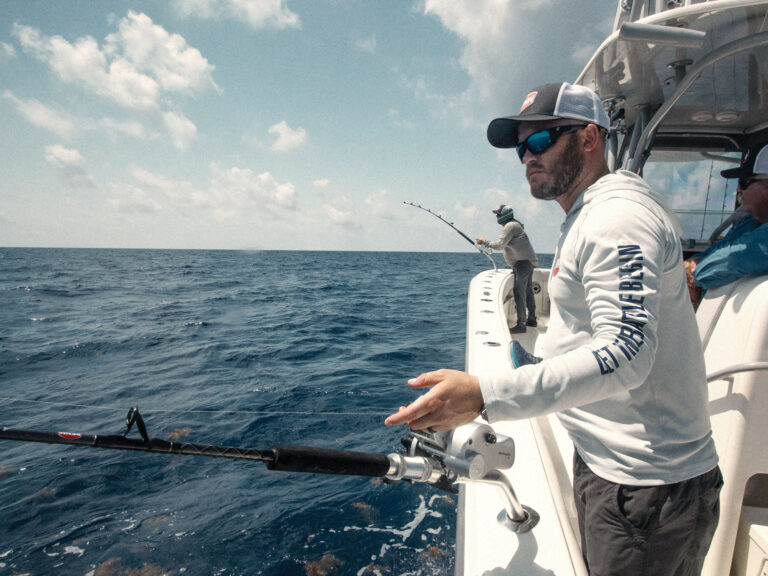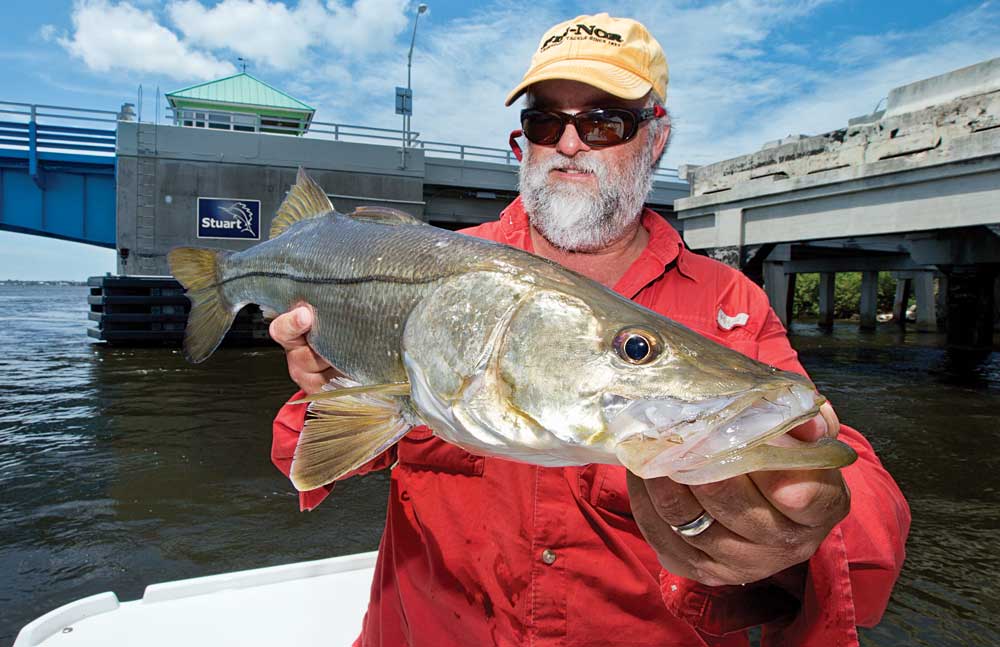
From high in the tower of our bay boat, Capt. Rufus Wakeman saw the snook first. “There they are,” he said, “30 fish or more lying above the sand right next to the rocks. Some big ones too.” We had motored slowly around the north jetty of the St. Lucie inlet in Stuart, Florida, looking for that very thing. I tossed a live pilchard (scaled sardine) close to the rocks, and within seconds, I saw a subsurface flash, and my line came tight as a snook engulfed the baitfish. Snook strike hard, and the fight was exciting as the fish tried to head for open water. But after a few minutes, I brought the tired fish alongside the boat, and we released it, scoring our first snook of the day.
Down to the Crossroads
The famed Crossroads area of Stuart might offer the best snook fishing in Florida, a statement that anglers along the state’s southwest coast will surely dispute. But the Crossroads — where the St. Lucie and Indian rivers converge just inland of the St. Lucie inlet — offers a wealth of habitat with hundreds, if not thousands, of places where you might expect to find a hungry snook. No other place in Florida offers this diversity.
The inlet jetties provide outstanding habitat for the fish, especially in summer, but vast flats areas also hold points, potholes, channel edges and other submerged structure that the fish love to prowl in search of their next meal. Then there are the docks and bridges, above-water structures that hold snook as well. All of this adds up to great fishing opportunities.
Wakeman is not only an accomplished guide, he also owns the River Palm Cottages (see SWS Planner), a delightful, Old Florida-style fish camp. Wakeman has fished the area most of his life, and is an expert at predicting where and when a snook might be found. “I prefer outgoing tide because it creates a sense of urgency,” Wakeman says. “Predators like snook lie in wait as the tide ebbs at various areas, looking for the bait as it flees the flats.”
Capt. Mike Holliday, another well-known Stuart snook expert, says that the fish in the inlets are predictable. “They hold in one or two spots during the outgoing tide, then when the current stops, they move to their incoming tide spot during the slack tide,” he says. “If you know where they sit on each tide, you can set up during the slack tides and wait for the fish to come to you.”
Go Artificial
Although we were fishing live bait that particular morning, Holliday points out that lures can be extremely effective on snook when worked properly. “The best snook fishing with lures comes before about 8:30 a.m., when the light is low and the fish don’t get a good look at the lure,” he says. “Once the sun gets up, the fish see very well and will dog the lure, but not eat it. The majority of strikes you get after that are going to be reactionary-type strikes, which dramatically decreases the number of hookups.”
Live bait works better in the glare of the midday sun, but then live bait is almost always effective. It just comes down to personal choice, as some people greatly prefer fishing artificials. But there’s strategy involved with baitfishing too. “If a fish eats a bait and you miss it, don’t reel the bait away from the fish,” Holliday says. “If you leave it there, the fish thinks it just escaped from its jaws, and will hunt it down and eat it again.”
Bridge Game
Some of the largest fish come from around the pilings of Stuart’s numerous bridges. Some of the best action takes place on topwater plugs worked around the bridges at night during the fall mullet run. “When mullet swim into the light, it disorients them, and they freeze and just drift through the light with the current, so you want to do the same thing with your topwater plug,” Holliday says. “Work the lure through the dark areas and pause when it comes into the light. It seems weird to stop the lure, but the current will carry it through the light, and the fish will crush it even when it’s not moving.”
Of course, you can also fish live mullet around the bridges with deadly results, and it’s key to use circle hooks, both for effective hookups and for conservation reasons. “Circle hooks really do work, you just have to have faith,” Wakeman says. “And don’t set the hook!”
**Flats Time **
Large grass flats around the Crossroads offer both wading and boat-fishing opportunity. “On the flats, I want an extreme low tide,” Holliday says. “That concentrates the fish in the deeper potholes and pulls them off the grass so there’s less terrain to cover. On extreme high tides, the fish on the flats can go anywhere, so they’re spread out. That’s when I like to fish seawalls because there’s a lot of water depth on the wall, and the big fish show up.”
Snook are still rebounding from the devastating cold of recent winters in Florida, but the fishery gets stronger all the time (see sidebar). But Holliday stresses that the fish need special care to make sure they continue to thrive. “I see a lot of people not respecting the fish, particularly during the spawning months, when we really need to take extra care to make sure the fish are handled gently, revived and released in good shape,” he says. “Too many people simply toss the fish back overboard instead of putting it gently back into the water and taking a minute or two to revive it. You have to remember that the fish you let go represents not only a larger fish in the future, but also a direct link to future generations of snook.”
Good points, ones that we all should heed if we hope to preserve this incredible fishery. With a little care, our children and grandchildren will all be able to enjoy the exceptional snook action found at Stuart’s Crossroads.
TRIP PLANNER
Crossroads Snook
The State of Florida has managed snook conservatively since the population of fish was hit hard by cold weather a few years ago. Some estimates put the loss of adult snook at 50 percent. But that conservative philosophy seems to be paying dividends, as the fish become more plentiful and larger in average size as time goes on.
For up-to-date snook regulations in Florida, go to** eregulations.com/florida/fishing/saltwater.**
What: Snook
When: Year-round
Where: Stuart, Florida
Who:
**Capt. Rufus Wakeman **
Hot Tuna Charters
772-486-1018
www.riverpalmcottages.com/fishing.htm
Capt. Mike Holliday
Fish Tales Guide Service
772-341-6105
Accommodations:
River Palm Cottages and Fish Camp
Jensen Beach, Florida
800-305-0511
Tackle
Rods: Spinning, plug-casting rods sized to fish 12- to 20-pound braid or mono.Fast action is helpful for casting.
Reel: 4500-class spinning reels, -midsize baitcasters.
Terminal tackle: 30 to 36 inches of leader tied to the main line (braid or mono) with an Albright Knot, and tied to the lure or hook with a Loop Knot.
If throwing lures, use 30-pound fluorocarbon leaders; if using bait, use 40-pound fluorocarbon. Use a 3/0 to 5/0 circle hook with bait, depending on the size of the pilchard, threadfin, sardine or pogey.
In the inlets, opt for 60-pound fluorocarbon leaders with 6/0 circle hooks, to release spawning fish quickly.
With topwater plugs around docks and bridges, go with 20-pound line for long casts, and a 40-pound-fluorocarbon leader.

